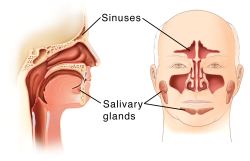Paranasal Sinus Tumors
Paranasal Sinus Tumors
A paranasal sinus tumor is a cancer that has grown inside your sinuses, the open spaces behind your nose.
This tumor can begin in the cells of the membranes, bones, or nerves that line the area. You might not know or even suspect that a tumor is growing until it spreads. The sooner you get a diagnosis and start treatment, the better your chances of beating the cancer are likely to be.
Causes of paranasal sinus tumors
Not all paranasal sinus tumors have known causes, but these are possible causes of paranasal sinus tumors:
Exposure to industrial chemicals
Being infected with the human papillomavirus (HPV)
Exposure to wood, leather, flour, textile, nickel, or chromium dust
Exposure to radium
Smoking cigarettes
Symptoms
Early symptoms of paranasal sinus tumors are similar to symptoms of colds or infections, so they're often missed:
Blockage of sinuses, or congestion that never goes away
Changes in your voice or breathing
Reduced sense of smell
Headaches
Numbness or pain in your face, ears, or teeth
Teeth that become loose
Pus draining from your nose or postnasal drip
Frequent nosebleeds
Growth on your face or palate
Eyes that continuously water
Bulging eye
Loss of or change in vision
Trouble opening your mouth
Call your doctor if you have any of these symptoms.
Diagnosis
A doctor will typically take your health history and do a physical exam. The physical exam will include looking at your eyes, ears, nose, mouth, face, neck, and throat. Any details you can provide about any pain you are having can help with the diagnosis. This includes details such as whether the pain is sharp, burning, dull, or achy, where it's located, and when it occurs.
Your doctor might order an endoscopy of your sinuses. This is a procedure in which a thin tube with a tiny light and a video camera on the end is inserted into your sinuses. Looking inside your sinuses will help your doctor figure out the location and size of the tumor.
Your doctor might order these tests, as well:
Blood tests
Imaging tests of your skull, such as X-rays, CT scans, or MRI of the sinuses
Imaging tests of your chest
A biopsy, where a small tissue sample from the tumor is removed and checked in a lab for signs of cancer
Staging
Part of the diagnosis process is called staging. This tells your doctor how advanced the cancer is and whether it has spread to other parts of your body. Staging helps your medical team create the best treatment plan for you.
The stage of your cancer depends on where the tumor is, how much it has grown into nearby areas, whether it has spread to lymph nodes or other parts of your body, and some other health factors. The stages range from I (earliest stage) to IV (the most advanced). Stages for paranasal sinus tumors are:
Stage I. The tumor is contained in the sinus and has not spread.
Stage II. The tumor has spread into other parts of the sinus.
Stage III. The tumor has spread into the bone of the sinuses or the eye socket and may have spread to a lymph node.
Stage IV. The tumor has spread deeper into the eye socket, into the brain, or into other parts of the skull and neck, and possibly to more distant parts of the body and may have a larger presence in the lymph nodes.
Treatment
The most common approach to treating a paranasal sinus tumor is a combination of surgery and radiation therapy. The goal of surgery is to remove as much of the tumor as possible. If the cancer has spread to lymph nodes, they will be removed as well. Surgery will be planned to preserve as much of your face and function as possible. Surgery can be complex and may involve a variety of specialists, such as doctors who specialize in the ear, nose, and throat (ENT doctors or otorhinolaryngologists), neurosurgeons, and maxillofacial surgeons.
Radiation therapy may be given before surgery to attempt to shrink the tumor. Or it may be given after surgery to destroy any remaining cancer cells. In this case, it will usually start several weeks after your surgery to allow enough time for your body to heal. Radiation might also be the main treatment in some cases, such as if a person can’t have or does not want surgery.
Chemotherapy is the use of medicines that destroy cancer cells. It is often used for cancers that might return or that have returned after the first treatment approach. Chemotherapy use is determined on a case-by-case basis. You might be given a combination of chemotherapy medicines or a combination of chemotherapy and radiation, called chemoradiation.
Treatment will also include pain management. Let your doctor or nurse know if you are in pain so it can be better managed.
Complications
Paranasal sinus tumors and their treatment may lead to these complications:
Scarring from surgery
Long-term changes in vision, breathing, speech, chewing, or swallowing, caused by the tumor or surgery
Nerve damage that can affect sensation in your face and movement in your face, shoulder, or arms
Side effects from radiation therapy, such as pain, nausea, trouble eating, mouth sores, loss of teeth, and changes in taste
Cancer spreading to other parts of your body (metastasis)
People who are treated for paranasal sinus tumors should continue to meet regularly with their doctor. If the cancer returns, it is most likely to happen in the first few years after treatment.
Updated:
January 18, 2018
Sources:
Paranasal sinus cancer, UpToDate.
Reviewed By:
Alteri, Rick, MD,Jasmin, Luc, MD
